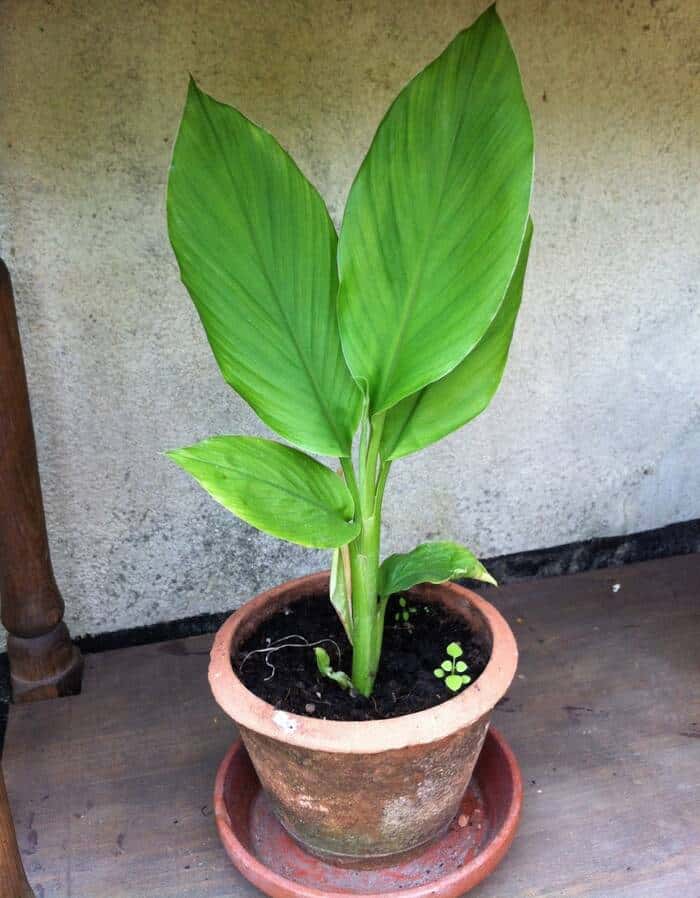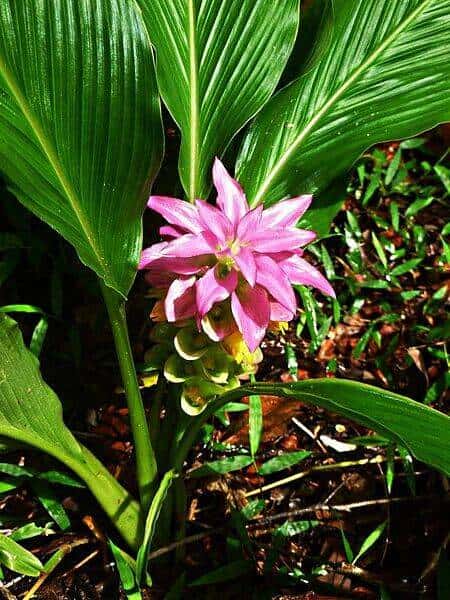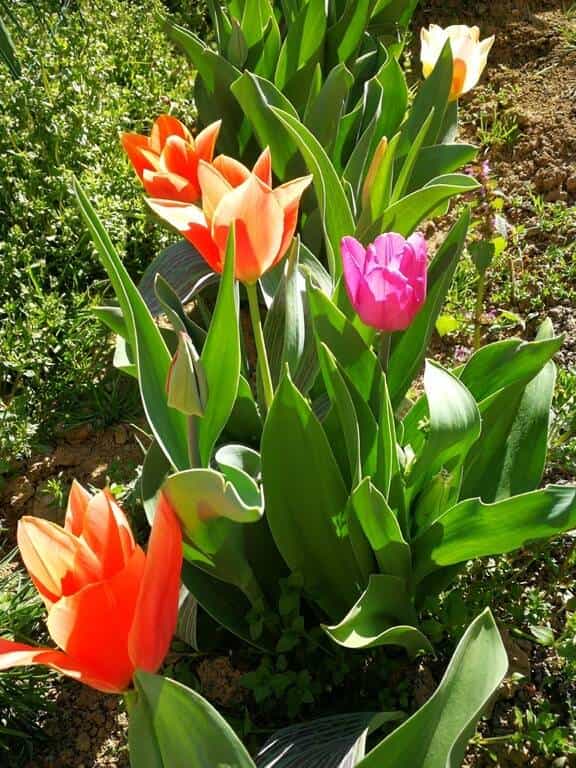How do you take care of the turmeric plants in the pot? How to grow the turmeric plant in a pot? To maintain it? When and how to prune it? How to water it? When and how to repot it? How to keep it? And what are its usual diseases?
I- How do you take care of the turmeric plants in the pot?
Turmeric is a rhizomatous plant, herbaceous of Asian origin. It comes to us more precisely from India as its name indicates.
Turmeric is a rhizome of the Zingiberaceae family and therefore contains several properties beneficial to human health and well-being.
Composed mainly of curcumin, turmeric has anti-inflammatory, antioxidant, and antibacterial properties.
It intervenes in the healing of several ailments as much as it serves to prevent many diseases by strengthening the immune system.
For all these reasons, turmeric has succeeded very early in becoming an essential part of traditional Asian medicine.
In the kitchen, turmeric is no longer an ingredient to be presented. It adds a special touch to menus and facilitates the preservation process of food.
In addition to being a spice with a unique taste, turmeric is an excellent beauty ally. It effectively fights against skin imperfections and solves hair problems.
In textiles, turmeric is again involved in the process of coloring fabrics. In short, whether in one field or another, in one form or another, turmeric has proven itself.
Today, due to these multiple virtues, turmeric is unanimously accepted by its consumers and ensures their well-being, which is why they have the ultimate need to have it constantly close to them.
# How to grow turmeric plant in pot?
The good news is that despite its origins, turmeric adapts easily to temperate climates when planted. To successfully plant turmeric in a pot, you must first choose the right period (between February and May).
Then you need to get fresh, healthy, and organic turmeric rhizomes. Indeed, there is a wide range of turmeric (40 perennial species in tropical regions).
But, to succeed in your experiment and take advantage of the benefits of this plant, it is preferable to opt for turmeric longa (especially if the rhizomes will be later intended for consumption) which is a variety rather easy to cultivate and very practical.
Place the rhizomes in a dish on a base of water near a source of heat or even indirect light for days.
Keep the contents at a minimum temperature around 20° C to avoid rotting until you see the roots appear.
This step seems easy, but in reality, it is an important step since its failure is enough to discourage you and ruin your project.
It is after this first step that you must plant the germinated rhizomes in a pot and watch carefully over their growth until repotting.
# Choosing a pot?
Put at the bottom of a pierced pot, a layer of clay or gravel. Then add a mixture of river sand with organic potting soil before planting the turmeric in a pot. Do not overwater.
Make sure to keep the substrate moist during the growing season (spring to fall).
Do not leave water in the saucer, but mist the foliage in dry conditions. The slightest excess of water could cause the plant to rot.
Stop watering as soon as the leaves start to turn yellow (September). It is important to choose a large enough pot and to give it the maximum care when repotting.
Because it is at the time of its growth that turmeric reminds us of its Indian origins.

# Where to find the rhizome or turmeric plant?
The best place to find fresh turmeric rhizome is in garden centers and organic food stores.
You can also look on the internet where many online stores sell very good quality turmeric rhizomes.
# How to prepare the pot (Potting)?
Put a layer of clay or gravel at the bottom of a pierced pot. Then add a mixture of river sand and organic potting soil before planting the turmeric in the pot. Do not overwater.
Make sure to keep the substrate moist during the growing season (spring to fall).
Do not leave water in the saucer, but mist the foliage in dry conditions. The slightest excess of water could cause the plant to rot.
Stop watering as soon as the leaves start to turn yellow (September). It is important to choose a large enough pot and to give it the maximum care when repotting.
Because it is at the time of its growth that turmeric reminds us of its Indian origins.
# Why repotting?
Now, it will be necessary to repot delicately the plant in a larger pot with a hole at the bottom. The substrate that supports the turmeric plant must be richly constituted and well-drained (without excess).
Although it is a plant that easily tolerates indirect indoor light, it would be appreciated to put the pot from time to time in a semi-shaded and airier area such as the balcony or on a windowsill.
The growth of turmeric should not be interrupted at any time. To do this, it is necessary to water the plant regularly (preferably in the mornings with water at room temperature and make sure to let the substrate dry slightly between two watering) by avoiding splashing the foliage.
Moreover, it is not at all recommended to leave stagnant water in the pot at the risk of losing the plant.
Water
To check the humidity level of the substrate, dip a finger in the pot. If the substrate is sufficiently moist, it is better to delay watering. If not, you can start watering immediately.
Fertilizer
You can also give the plant liquid fertilizer once a month, i.e. a maximum of three times during the growing season.
When all these conditions are respected, the rhizomes grow remarkably and you can expect a good harvest.
By the way, at the end of its cycle, or the end of the vegetation period (October-November), the plant goes into dormancy and the leaves start to dry.
At this time, it is necessary to gradually reduce the rhythm of watering until stopping them definitively. Now you can dig up the plant and proceed with the harvest.
Position
It is advisable to plant your turmeric rhizome away from the wind to prevent it from breaking the stem, especially when it is still frail.
In the tropics, turmeric is usually planted in diffuse shade and does not like direct, intense sunlight all day.
For this specificity of the turmeric plant, you should keep it in full sun when it is a very sunny area all year round.
But in temperate climates, which is moderately sunny, you can in this case put the plant directly facing the sun.
So you can give it a little sun in the morning to encourage its growth and a little shade in the afternoon to not risk burning it.
Temperature
The ideal temperature for growing turmeric is between 20 and 35 °C (68-95 F).
When the temperature exceeds 35 °C (95 F), care must be taken to monitor the humidity of the soil to avoid the dryness of the plant.
And every time you feel the soil dry, put a little more water.
On the other hand, if the temperature drops below 10 °C (50 F) the plant may get sick and suffer.
Overwintering
In winter, to prevent the roots of the turmeric plant from rotting in very low temperatures, it is advisable to bring your pot inside the house.
The ideal temperature for this plant is 20 °C (68 F).
And for more precaution, it is better to put your plant in front of a bay window, with as much sun as possible, because it needs luminosity to grow well.

# By the way, when to repot turmeric?
The repotting of turmeric rhizomes is done in spring in a half-shaded area. You can repot your rhizome and plant it in your garden or at least on rich soil by burying it only very slightly; about 3 to 4 cm deep.
If you prefer to plant in a pot or indoors, you will just have to repot your rhizomes in a larger pot adapted to the plantation.
The essential condition at this time is that the substrate is as rich as if the plantation was done in a garden.
During this period, the plant needs a lot of water; regular watering is thus recommended as already specified above.
II- How to grow your own turmeric indoors and it safe?
The conservation of turmeric rhizomes is the step that follows the harvesting. Already during the resting period of the plant (October-November);
The slightest excess of water is enough to make the plant rot. The same principle remains valid after the harvest that’s why the rhizomes remaining after the harvest must be preserved in a dry and ventilated pot.
This process of conservation allows to avoid the appearance of mold on the remaining rhizomes and to keep them healthy until the next season.
III- Which soil for turmeric?
Turmeric’s soil requirements are not great. Nevertheless, to successfully grow turmeric, sandy soil, rich in humus and covered with potting soil is ideal to start.
The soil on which turmeric rhizomes are planted should be neutral, light, sufficiently drained, and moderately exposed to the sun.
After two years of exploitation of the same substrate or soil, it is recommended to renew the components, because, from this moment, the tired soil becomes less fertile and slows down the growth of the plants.
IV- How to cut turmeric flowers?
The rhizomes of turmeric have a generally green, deciduous foliage with an erect habit. Its leaves can belong up to 1-meter high.
As for the pink spike inflorescences, they are very showy and house small purple and white flowers.
To remove faded turmeric flowers, cut the stem as low as possible to facilitate the production of a new flower later.
V- How to propagate turmeric?
The multiplication of turmeric is done by division during spring. At this stage, it is necessary to split the rhizome pieces that you initially kept in autumn and that contain at least one bud.
Then wait for the wounds caused by the division to dry before planting.

VI- Why are my turmeric leaves turning yellow (disease)?
Yellowing turmeric leaves are a negative message, related to several factors.
The symptoms are first manifested by a part of the leaves affected by a yellow spot that spreads rapidly.
Then comes the stage of the leaves falling, slowing down the growth of the plant.
In general, this phenomenon indicates either:
1. Excessive or insufficient watering
Excessive watering, especially for potted turmeric plants, causes yellowing. Because an excessively soaked substrate causes asphyxiation of the rhizomes.
While the plant which does not manage to feed itself correctly has difficulty in growing. And since it is a question of an irremediable phenomenon, the leaves fall and the plant dies.
The best way to make your turmeric grow is to pay attention to its watering because it is not only the excess of watering that causes problems but also the insufficiency.
Lack of water also causes turmeric leaves to wilt and turn yellow quickly.
2. Chlorosis or deficiency
Yellowing of the leaves is in some cases the effect of an iron or mineral deficiency. It means that the plant is no longer supplied with chlorophyll.
The leaves turn yellow from the edge to the veins.
3. Poor exposure
In other cases, the yellowing of the leaves is not due to bad watering nor a lack of nutrients for the plant, but rather to an unsuitable exposure.
The turmeric plant is, in fact, hostile to draughts and strong thermal amplitudes.
Thus, if the growth of your turmeric plant in a pot requires a minimum of heat, it is however necessary to take care that they are not excessively subjected to the sun.
Apart from all these cases is the possibility that yellowing only indicates that some leaves are old and need to be removed to make room for new ones.
VII- Turmeric plant rotting?
To avoid the rotting of your potted turmeric plant, you should stop watering immediately when the foliage looks wilted.
Do not resume watering until the first stem is visible. Generally, rotting is caused by a bad start of the vegetation or by watering with hard water.

VIII- How to germinate a turmeric rhizome in water?
To germinate a rhizome of turmeric it is necessary to have chosen beforehand a healthy rhizome, organic, fresh, and easy to plant.
Pour in a bowl a little water and put the rhizome. Expose the dish and the contents to a heat source for several days.
Be careful with the temperature (at least 20 degrees Celsius) to avoid rotting the rhizome.
You will see the rhizome sprouting. When the shoots reach a few centimeters, you can from this moment, consider your rhizome as ready to be planted.
IX- Conditions of purchase of turmeric
Although of Indian origin, turmeric is now so widespread in the world that there is no difficulty to find its rhizomes wherever you are.
In Us, you can find turmeric rhizomes either in exotic food stores or more easily on the web.
During the purchase, it is important to make sure of the quality of the rhizome. The rhizome must be fresh and healthy.
X- Turmeric benefits
Turmeric is one of the most sought-after spices for its multiple properties, both preventive and curative.
It is mainly used, in addition to its culinary usefulness, for its anti-inflammatory and antioxidant virtues, which several scientific studies point to its ability to prevent certain cancers and protect against diseases related to aging.
Turmeric is also known to treat digestive disorders, soothe pain due to gastritis and other inflammations of the intestine, and thus plays a protective role for the stomach and liver.
Its anti-inflammatory properties make it an excellent remedy for acne and are able to repair sun-damaged complexions and brighten the skin.
All this makes turmeric one of the most popular spices in cosmetics.
XI- Price of the turmeric plant in pot (in The US)
In the United States, the price of turmeric plants varies according to the width and content of the pot or other times according to the variety.
For turmeric, Siam tulip;
Pot Size: 3.25” with 2 to 3 turmeric flowers costs about 15 dollars to 20 dollars.
hoping after reading this article you don’t have many questions left regarding how do you take care of the turmeric plants in the pot